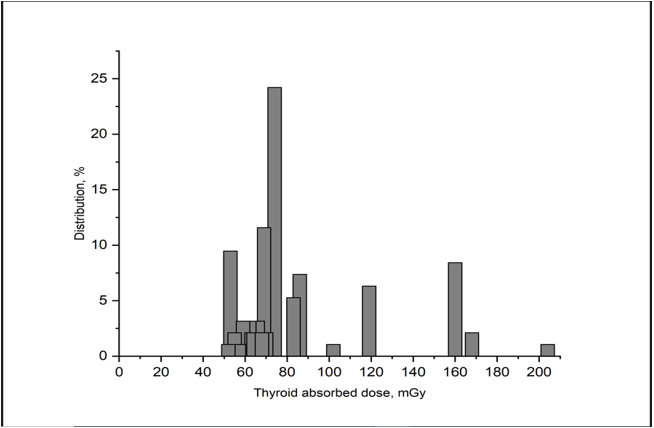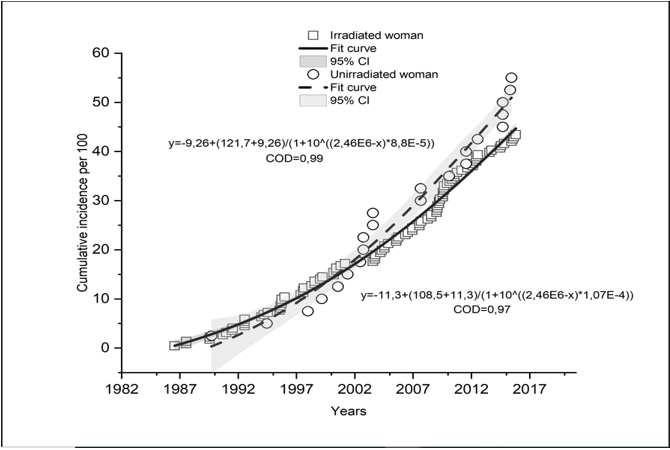Mini Review 
 Creative Commons, CC-BY
Creative Commons, CC-BY
Gastrointestinal Pathology in the Long-Term Period After the Chernobyl Accident in Women Exposed to Radioactive Iodine During Pregnancy
*Corresponding author: Alexander N Stojarov, pr. Dzerzhinskogo 83, Department of Radiation Medicine, Belarusian State Medical University, Belarus.
Received: July 27, 2023; Published: August 17, 2023
DOI: 10.34297/AJBSR.2023.19.002645
Abstract
In a cohort of women who in 1986 during pregnancy suffered from the accident at the Chernobyl nuclear power plant due to exposure to radioactive iodine (I-131), over the next 30 years, no differences were found in the incidence of the gastrointestinal tract pathology, compared with the control group. The dominant pathology was chronic cholecystitis and varieties of gastritis. This data indicates that there is no relationship between thyroid irradiation and pathology of the digestive system.
Keywords: Radioactive iodine, I-131, Morbidity, Incidence, Gastrointestinal tract, Chernobyl disaster
List of Abbreviations: ICD-10: International Classification of Diseases; ChNPP: Chernobyl Nuclear Power Plant.
Introduction
To study the medical consequences of the disaster at the Chernobyl Nuclear Power Plant (ChNPP), we formed a cohort of women from the Stolen district of the Brest region, who in April-May 1986 were exposed to radiation from a radioactive cloud, which contained iodine isotopes together with other radionuclides [1]. The women in this cohort were at different stages of pregnancy at that time. For information, the Stolin region of Belarus borders on Ukraine and it is near the Chernobyl nuclear power plant. The choice of residents in this area was due to two reasons. Firstly, pregnancy is a physiological state of the body, which is characterized by the overstraining of many organs and systems, and therefore it is of interest to study the effect of radiation on the absence or presence of subsequent pathology in this group. Secondly, on the example of their irradiated fetuses, i.e., subsequently born children, it is also possible to study the effect of intrauterine exposure on health status during their later life.
When studying the incidence of pathology in women who were irradiated during pregnancy, we found an increase in the number of pathologies from the side of cardiovascular system, the respiratory system many years and even decades after exposure [2,3]. Among diseases of the cardiovascular system, essential hypertension prevailed [3]. These changes were dose-dependent in relation to absorbed doses by the thyroid gland of pregnant women. For example, morbidity maxima were recorded at doses of 70 and 160 mGy. In view of all this, the analysis of morbidity caused by pathologies of other organs and systems is of undoubted interest. In this regard, in this study, we tried to study the incidence of gastrointestinal pathology in irradiated women in the long-term period after the exposure.
Materials and Methods
The study included a cohort of women (221 women) who were exposed to radioactive iodine as a result of the accident at the ChNPP (April-May 1986) and were at various stages of pregnancy during this period. The average age of those women at the time of the accident at the Chernobyl nuclear power plant was 24 years. The search for these people and their identification was carried out using the databases of the State Register of Persons Affected as a Result of the Chernobyl Accident, which had medical records. Only primary morbidity was considered in the work. As a comparison group, the study included women from the same Stolin district of the Brest region (40 women), whose pregnancy occurred later, i.e., in 1987. Due to the short half-life of I-131 (8 days), after a year, i.e., in 1987, there was almost no iodine in the environment and it did not affect health of pregnant women. The average age of women in the comparison group was 22 years.
Absorbed doses by the thyroid gland due to I-131 were calculated by the head of the laboratory for the reconstruction of exposure doses to the population of the State Scientific Center of the Federal Medical Biophysical Center named after A.I. Burnazyan, FMBA of Russia, Doctor of Technical Sciences, Shinkarev S.M. Doses were calculated using a semi-empirical model from the 2004 iteration. Gastrointestinal pathology was classified according to ICD-10. Statistical data processing was carried out using the application software Statistics 10.0 (StatSoft. Inc., USA) and SigmaPlot 12.5 (Systat Software Inc., Germany).
Results and Discussion
At the beginning of the study, it was necessary to analyze the doses absorbed by the thyroid gland, which were formed mainly due to I-131. Figure 1 shows this data. It is clearly seen that doses absorbed by the thyroid gland are mainly grouped in the range of 50-90 mGy, although there are also larger absorbed doses with values of 160 and 200 mGy. It should be considered that the leading factor in the formation of doses absorbed by the thyroid gland was the intake of the radionuclide by the way of inhalation, as well as the intake of iodine into the body by the way of the consumption of the whole milk. Of undoubted interest is the analysis of the structure of the pathology of the gastrointestinal tract. In irradiated women, chronic cholecystitis (K81.1) dominated - 17.14%. In second place there were varieties of gastritis (atrophic - K29.4, superficial - K29.3 and acute gastritis - K29.1). Much less common gastroenteritis and gastritis of non-infectious origin, as well as duodenal ulcer (Figure 2A). Approximately similar picture was found in the analysis of the incidence of non-exposed women (Figure 2B). In the first place, with approximately the same frequency as in the previous case, there was chronic cholecystitis. Acute biliary pancreatitis (K85.1) occupied the second place, followed by gastritis and gastric ulcer. In other words, the incidence patterns of both exposed and non-exposed women were quite similar.

Figure 1: Assessment of the effect of emergency radiation therapy on patients, an effect on overall survival (OS).

Figure 3: Cumulative morbidity of the main (irradiated) and control (non-irradiated) groups of women.
At the next stage of the study, we analyzed the cumulative incidence of all types of pathology of the gastrointestinal tract for 30 years after the Chernobyl accident (Figure 3). Already at first glance, it becomes obvious that the incidence plots in both groups are almost the same with each other. Both curves are characterized by a time-dependent function and almost overlap each other. The constants in the formulas describing these curves are very similar to each other. Of interest is the interpretation of the obtained data. As mentioned above, we have previously identified a relationship between radiation exposure of the thyroid gland and the subsequent development of cardiovascular system pathology [2]. We explained these data by different sensitivity of genes expressed in thyroid gland (Mb, MYG, Pax8, Sic5a5, Tg, Tpo) to the effects of radioactive iodine (I-131) [4,5]. This influence can change the balance of secreted thyroid hormones, accompanied by persistent instability of the genome and, as a result, the subsequent appearance of non-oncological pathology. Meanwhile, it is known that the function of various parts of the gastrointestinal tract is also regulated by thyroid hormones [6-8].
However, the absence of significant changes in the incidence of the digestive organs pathology in the group of exposed women suggests that these genes, and so the balance of the main thyroid hormones, are not involved in the mechanisms of regulation of the main functions of the digestive system of the body. Thus, it can be concluded that irradiation of the thyroid gland with radioactive iodine does not have a significant effect on long-term morbidity from the side of gastrointestinal tract organs. Thus, it can be assumed that the growth of this pathology in the main and control groups is not associated with thyroid irradiation but may be a consequence of other factors (lifestyle, dietary habits, environmental factors, food quality, etc.). One of the reasons for this may be the impact of radiation on the gastrointestinal tract due to the consumption of contaminated food by the population. Even 30 years after the accident, basic foodstuffs are contaminated to varying degrees with radioactive cesium (Cs-137). And, although food contamination has decreased due to the protective measures taken, it continues to occur and can be a factor that negatively affects the state of human stomach, intestines, and liver.
Conclusion
Irradiation of the thyroid gland with radioactive iodine in women during pregnancy is not accompanied in the long term by the growth of pathology from the side of gastrointestinal tract. The incidence structure in women irradiated during pregnancy is identical to that in the control group, i.e., cohort of women who were not exposed to radiation during pregnancy.
Acknowledgement
None.
Conflict of Interest
None.
References
- AN Stojarov, VV Khrustalev, NS Bondareva (2023) Analysis of the cohort and incidence in persons exposed to radioactive iodine during fetal development. Medicinskij zhurnal (2): 98-203.
- Stojarov AN, Khrustalev VV, Adzintsova Stazharava DA (2021) Cardiovascular Pathology in Women Who Received Radioactive Iodine Exposure During Pregnancy as a Result of the Chernobyl Accident. BJSTR 37(2): 29320-29328.
- Stojarov AN, Vladislav V Khrustalev (2022) Delayed Consequences of The Radioactive Iodine Intake by Pregnant Women from The Side of Respiratory System. AJBSR 15(2): 210-216.
- Stojarov AN, Khrustalev VV (2021) Essential Hypertension after Radiation Exposure. JSM Environ Sci Ecol 9(1): 1076-1080.
- Rudqvist N, Emil Schüler, Toshima Z Parris, Britta Langen, Khalil Helou, et al. (2015) Dose-specific transcriptional responses in thyroid tissue in mice after (131)I administration. Nucl Med Bio 42(3): 263-268.
- Gregory CH, Gregory RF, Gregory R (1969) Effect of endocrine glands on function of the gastrointestinal tract Study of the thyroid, parathyroid, and adrenal glands. Am J Surg 117(6): 893-906.
- Koldovský O, M Dobiásová, P Hahn, J Kolínská, J Kraml, et al. (1955) Development of gastrointestinal functions. Physiol Res 44(6): 341-348.
- Kumar V, Prasad R (2003) Thyroid hormones stimulate calcium transport systems in rat intestine. Biochim Biophys Acta 1639(3): 185-194.




 We use cookies to ensure you get the best experience on our website.
We use cookies to ensure you get the best experience on our website.